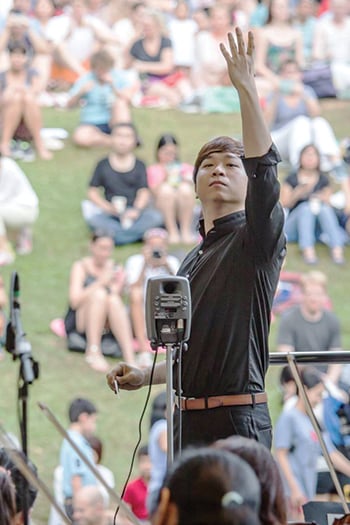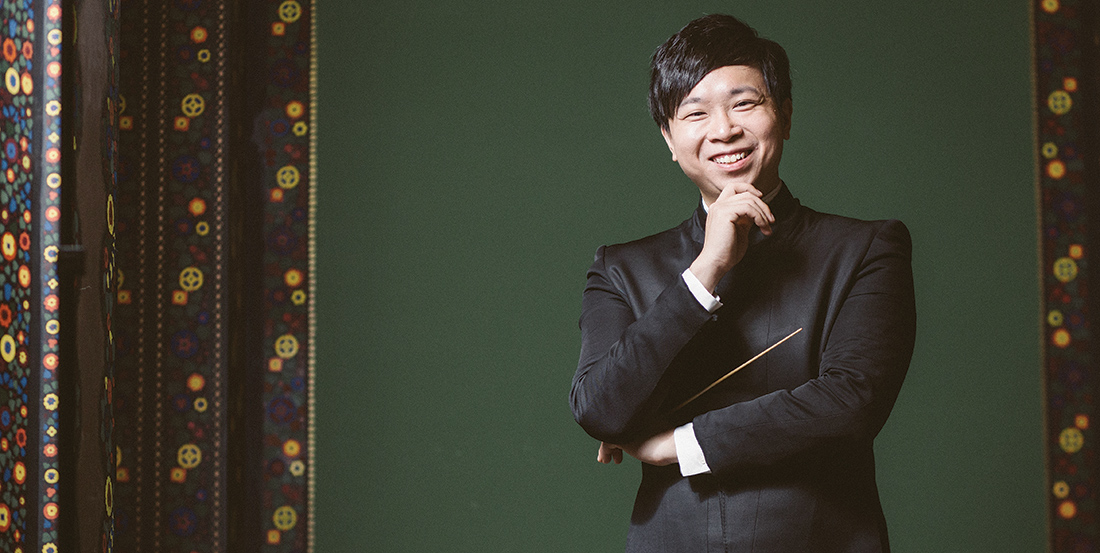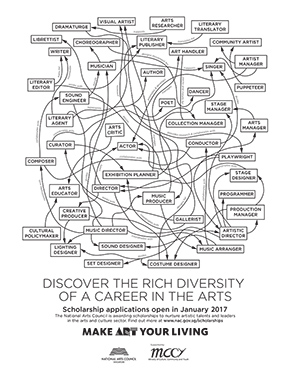T he Arts is more than just an industry – its expression is a way of life. Fuelled by the diverse and flourishing opportunities within the international arts space, Singaporean artists have taken bold steps to share their works with the wider international audience.
Two of these Singaporean artists are Wong Kah Chun, an artistic director and guest conductor with various orchestras, and Choy Ka Fai, an independent visual artist. Both individuals, who are also recipients of the NAC Arts Scholarship, chose to make the Arts their lifelong commitment from the get-go. They tell us about their artistic adventures overseas, and why they chose the less trodden path.
When did you begin your artistic journey?
Wong Kah Chun: I joined the brass band in Primary 1, and it was fun to have made music with my friends. I remember that in Primary 6, during a civics and moral education class, we had to list an ambition – I wrote ‘musician’, which made the entire class including the teacher laugh!
Music has been an integral part of my social life – my friends and I learn together, go for competitions and cultural trips together, foster teamwork and discipline together, and most importantly, grow up together.

Choy Ka Fai
Recipient of the NAC Arts Scholarship
Independent Artist
Choy Ka Fai: I started drawing when I was young and was involved in theatre productions during my Junior College days. My first public performance was in 1997 at the Singapore Arts Festival, where I was exposed to the various elements of music, dance and visual arts. It sparked my interest in an arts career, and I decided to enrol myself into the LASALLE College of the Arts instead of a conventional university course in Singapore.
Tell us where and what you studied.
Kah Chun: My scholarship made it possible for me to study at the prestigious Hans-Eisler Musikhochschule in Berlin, where I received my Master of Music in Orchestral / Opera Conducting. There’s no better place in the world than Berlin to study classical music, considering its long tradition of great composers who worked in the city, and its eight full-time symphony orchestras and three opera houses. I would attend a rehearsal or concert almost every other day, which provided the best learning opportunities for a young conductor!
Ka Fai: The NAC Arts Scholarship provided tremendous support financially as I was studying at the Royal College of Art in London, one of the most expensive universities in the UK.
I was accepted into the Design Interaction Master programme based on my artistic portfolio, and went through critical design studies on emerging technologies for the future. At the same time, I was also given free rein to pursue my personal artistic interests.

Wong Kah Chun
Recipient of the NAC Arts Scholarship
Artistic Director,
Asian Contemporary Ensemble Ltd (ACE)
Guest Conductor with multiple international orchestras
Give us an insight into your job.
Kah Chun: As the founder and the artistic director of ACE, my responsibility is to chart out a whole new world across genres – from western classical music to traditional asian heritage. Curating extraordinary performances and thinking out of the box are aspects of my role which I really enjoy. For example, our opening concert of the 2016 season is entitled XperienZ: In C, which sits our audiences in between our musicians, experiencing Beethoven’s Fifth Symphony in C minor from the inside out! We also performed the first work of the minimalist period, entitled In C by Terry Riley, which encouraged audiences to BYOI (bring your own instrument) and to jam along with us, creating a sense of involvement, interaction and insight to the contemporary music that we love.
Ka Fai: As an independent artist, I juggle administrative and creative works simultaneously. The organisation process is as important as the actual artistic process. For example, I would schedule for an intense period of creation or rehearsal in a dance studio, or plan for a week of documentary filming or research on location. All the pre-planning would provide the condition to maximise the potential of the entire artistic process.
Any memorable experiences from your time overseas?
Kah Chun: I remember very fondly Santa Fe Symphony in Argentina. This was in a small provincial town, six hours or so away from Buenos Aires. We performed the Sixth Symphony of Tchaikovsky, and at the end of the Third movement, the audience started clapping spontaneously before the movement ended. This was an audience that had not heard this work performed live for years. In the heart-wrenching finale, when Tchaikovsky’s life comes to an end, there was not a single cough or rustle or clap for close to one minute. It was extraordinary.
Ka Fai: One of my most recent projects titled ‘SoftMachine’ shed light on the contemporary status of dance across Asia though interviews, documentaries, collaboration and performance. The whole process was memorable, as I spent about three years travelling and conducting research in 13 Asian cities.
As a result, I collected an independent archive of video interviews with 88 dance makers and created four documentaries. The experience of meeting all these artists made it especially rewarding. SoftMachine has since been presented worldwide in 16 different cities.
Any parting words for budding artists in Singapore?
Kah Chun: Being a musician means our lives are devoted to our art. It is great to be on stage to share what we love with our audiences, but we have to be prepared for a lot of sacrifice. It is also important to understand that there are bound to be 99 rejections before one successful opportunity, especially in such a competitive environment!
If we are truly in love with what we do, then this is a calling, not a career. I have the good fortune of waking up daily looking forward to my work. The conducting profession is renowned for its longevity, with no such thing as retirement, and it is not rare to witness performances by conductors well into their 80s!
Ka Fai: To become a visual artist, you have to be very diligent, and possess a healthy sense of curiosity in order to keep motivated. It is also important as a visual artist to never stop believing in your craft.

